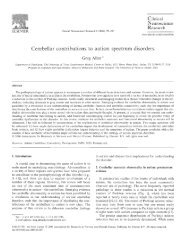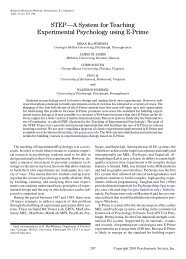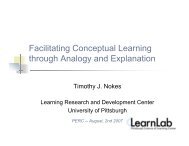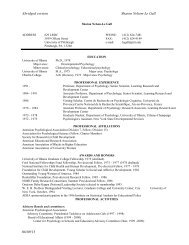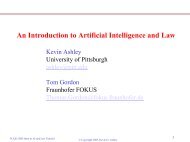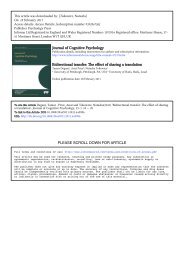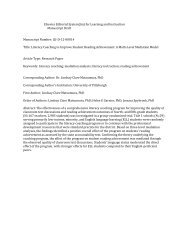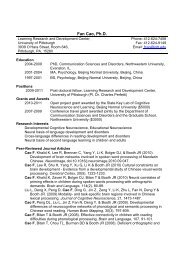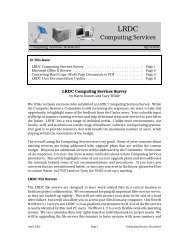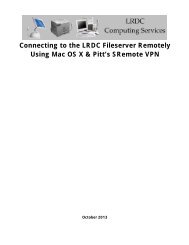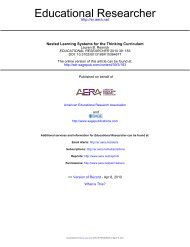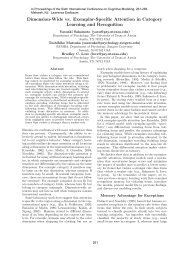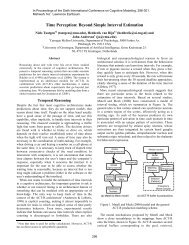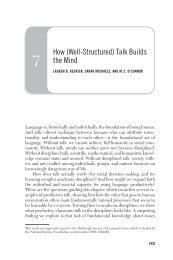[on] how people learn science - Learning Research and ...
[on] how people learn science - Learning Research and ...
[on] how people learn science - Learning Research and ...
Create successful ePaper yourself
Turn your PDF publications into a flip-book with our unique Google optimized e-Paper software.
esearchers Playing catch-Up<br />
in gauging Bey<strong>on</strong>d-School effects<br />
BY<br />
SaraH D.<br />
SParKS<br />
Emerging research s<strong>how</strong>s the <strong>science</strong><br />
school-age children <strong>learn</strong> in<br />
informal settings—from museums<br />
<strong>and</strong> clubs to <strong>on</strong>line communities<br />
<strong>and</strong> televisi<strong>on</strong> s<strong>how</strong>s—can have a<br />
big impact <strong>on</strong> their lives. Yet the<br />
open format <strong>and</strong> distinct structures<br />
of informal <strong>science</strong> make it next to<br />
impossible for researchers to evaluate<br />
the quality of those experiences<br />
in the same way they can gauge<br />
formal schooling.<br />
School assessments generally<br />
focus <strong>on</strong> cognitive measures, such<br />
as what a student knows <strong>and</strong> can<br />
dem<strong>on</strong>strate about particular c<strong>on</strong>tent.<br />
In c<strong>on</strong>trast, informal <strong>learn</strong>ing<br />
is dominated by n<strong>on</strong>cognitive<br />
measures such as motivati<strong>on</strong>, interest,<br />
<strong>and</strong> identity, according to<br />
Larry E. Suter, the Nati<strong>on</strong>al Science<br />
Foundati<strong>on</strong>’s program director<br />
for informal <strong>science</strong> educati<strong>on</strong>.<br />
Moreover, traditi<strong>on</strong>al “gold st<strong>and</strong>ard”<br />
research methods such as<br />
r<strong>and</strong>omized c<strong>on</strong>trolled trials can<br />
be detrimental to activities that<br />
base their strength <strong>on</strong> <strong>people</strong>’s<br />
choosing to participate, rather<br />
than being assigned.<br />
Such research raises the risk,<br />
Mr. Suter said, that “if you touch<br />
it, you’re going to kill that thing<br />
you’re trying to study.”<br />
That has led to some creative<br />
research alternatives. Alan J.<br />
Friedman, a former director <strong>and</strong><br />
chief executive officer of the New<br />
York Hall of Science <strong>and</strong> the editor<br />
of the n s f’s 2008 framework<br />
for evaluating informal <strong>science</strong><br />
educati<strong>on</strong>, recalls judging the effectiveness<br />
of an astr<strong>on</strong>omy exhibit<br />
by the number of visitors<br />
who chose an astr<strong>on</strong>omy poster<br />
over a different prize. Barbara N.<br />
Flagg, the director of the Multimedia<br />
<strong>Research</strong> c<strong>on</strong>sultant<br />
group in Bellport, N.Y., said<br />
she has used smudged museum<br />
walls indicating where<br />
visitors have touched exhibits,<br />
changes in Google <strong>and</strong> Amaz<strong>on</strong><br />
search terms over time, <strong>and</strong> ph<strong>on</strong>e<br />
interviews with parents <strong>and</strong> children.<br />
“If you’re comparing this to other<br />
educati<strong>on</strong> research, you’ve got to<br />
S6<br />
turn back the clock 30 or 40 years,”<br />
said Kevin J. Crowley, the director<br />
of the University of Pittsburgh’s<br />
Center for <strong>Learning</strong> in Out-of<br />
-School Envir<strong>on</strong>ments <strong>and</strong> an associate<br />
professor of educati<strong>on</strong> <strong>and</strong><br />
psychology. “We are just now in the<br />
Wild West fr<strong>on</strong>tier, <strong>and</strong> <strong>people</strong> are<br />
just starting to gear up the l<strong>on</strong>gitudinal<br />
studies <strong>on</strong> <strong>how</strong> this will coalesce<br />
into a coherent narrative of<br />
<strong>how</strong> <strong>people</strong> <strong>learn</strong> <strong>science</strong>.”<br />
Now, the tools being born of that<br />
creativity s<strong>how</strong> the potential to<br />
link children’s educati<strong>on</strong> across a<br />
lifetime of different experiences,<br />
<strong>and</strong> in the process uncover more<br />
of <strong>how</strong> <strong>and</strong> what children <strong>learn</strong><br />
than has ever been measured in a<br />
school test al<strong>on</strong>e. Children, after<br />
all, spend more than 80 percent<br />
of their waking hours outside the<br />
classroom.<br />
“The research has evolved,” Mr.<br />
Crowley said. “In the past, the<br />
great flaw of the informal-<strong>learn</strong>ing<br />
<strong>science</strong> was we looked at it in situ-<br />
“ We’re<br />
just now in<br />
the Wild<br />
West<br />
fr<strong>on</strong>tier<br />
... [<strong>on</strong>]<br />
<strong>how</strong> <strong>people</strong><br />
<strong>learn</strong> <strong>science</strong>.”<br />
KeViN J. crOWleY<br />
associate Professor of educati<strong>on</strong> <strong>and</strong> Psychology<br />
University of Pittsburgh<br />
ati<strong>on</strong>s; we weren’t really<br />
looking at a lifel<strong>on</strong>g trajectory<br />
in <strong>science</strong> <strong>learn</strong>ing. For<br />
the first time, we’re asking questi<strong>on</strong>s<br />
about <strong>how</strong> <strong>learn</strong>ing <strong>and</strong> participati<strong>on</strong><br />
are moving across place<br />
<strong>and</strong> across time.”<br />
“Brenda’s” school performance,<br />
for instance, didn’t really s<strong>how</strong> her<br />
scientific achievements or level of<br />
interest in the subject. Teachers<br />
reported the first-generati<strong>on</strong> Haitian<br />
daughter of a single mother<br />
in Seattle had little interest in<br />
<strong>science</strong> <strong>and</strong> c<strong>on</strong>sistently “failed to<br />
engage” with the chemical-mixing<br />
tasks in her school lab.<br />
Yet because researchers at the<br />
University of Washingt<strong>on</strong>, in Seattle,<br />
had been observing the 4th<br />
grader across formal <strong>and</strong> informal<br />
settings for more than 2,000 hours,<br />
they knew that school didn’t tell<br />
Brenda’s whole story. Not <strong>on</strong>ly did<br />
she regularly measure <strong>and</strong> mix<br />
chemicals <strong>and</strong> record the results<br />
for her perfume-making hobby,<br />
but she also had told the researchers<br />
she was c<strong>on</strong>sidering becoming<br />
a chemist when she grew up.<br />
“School <strong>science</strong> underrepresents<br />
her developing expertise,” Philip<br />
Bell, an associate professor of<br />
<strong>learn</strong>ing <strong>science</strong>s at the university<br />
<strong>and</strong> the director of ethnographic<br />
<strong>and</strong> design-based research at the<br />
Everyday Science <strong>and</strong> Technology<br />
Group there, said during a recent<br />
lecture. “Just in terms of <strong>how</strong> <strong>people</strong><br />
<strong>learn</strong>, our literatures d<strong>on</strong>’t do<br />
justice to the varied pathways that<br />
<strong>people</strong> take through their experiences<br />
to make progress <strong>on</strong> things<br />
they care about.”<br />
iNTereST VS. graDeS<br />
That’s a dangerous disc<strong>on</strong>nect,<br />
experts say, because<br />
mounting evidence s<strong>how</strong>s<br />
that early engagement,<br />
even through informal pathways,<br />
eventually can lead to<br />
careers in the stEm fields of <strong>science</strong>,<br />
technology, engineering, <strong>and</strong><br />
mathematics more surely than top<br />
grades in school.<br />
In a 2006 study published in<br />
the journal Science, Robert H. Tai,<br />
an associate professor at the University<br />
of Virginia’s Curry School<br />
of Educati<strong>on</strong>, in Charlottesville,<br />
tracked thous<strong>and</strong>s of students via<br />
the Nati<strong>on</strong>al Educati<strong>on</strong>al L<strong>on</strong>gitudinal<br />
Study. He found that<br />
students who had <strong>on</strong>ly average<br />
grades in middle school but expressed<br />
interest in <strong>science</strong> were<br />
two to three times more likely to<br />
earn bachelor’s degrees in a <strong>science</strong><br />
or engineering field 12 years<br />
later than high-achieving students<br />
who did not voice interest.<br />
The l<strong>and</strong>mark 2009 study that<br />
Mr. Bell co-wrote, “<strong>Learning</strong> Sci-<br />
Educati<strong>on</strong> WEEK: sciEncE lEarning outsidE thE classroom l www.edweek.org/go/<strong>science</strong>report l april 6, 2011<br />
What’s measured in the<br />
classroom—what students<br />
know <strong>and</strong> can do— differs<br />
from what’s currently measured<br />
outside—such as motivati<strong>on</strong><br />
<strong>and</strong> interest.<br />
ViTal liNKS<br />
<strong>learn</strong>ing Science in informal envir<strong>on</strong>ments: People, Places,<br />
<strong>and</strong> Pursuits (2009)<br />
The Nati<strong>on</strong>al <strong>Research</strong> Council of the Nati<strong>on</strong>al Academies,<br />
Edited by Philip Bell, Bruce Lewenstein, Andrew W. Shouse, <strong>and</strong> Michael<br />
A. Feder<br />
this l<strong>and</strong>mark study by the Nati<strong>on</strong>al Academies’ Committee <strong>on</strong><br />
<strong>Learning</strong> <strong>science</strong> in Informal Envir<strong>on</strong>ments documented evidence<br />
that children <strong>and</strong> adults do <strong>learn</strong> <strong>science</strong> outside of direct school<br />
instructi<strong>on</strong>. Both designed <strong>science</strong> settings such as zoos or<br />
museums <strong>and</strong> sp<strong>on</strong>taneous settings such as a walk in the park can<br />
help children underst<strong>and</strong> <strong>science</strong>. the book laid the foundati<strong>on</strong> for a<br />
more evidence-based approach to informal <strong>science</strong> educati<strong>on</strong>.<br />
Surrounded by Science: <strong>learn</strong>ing Science in informal<br />
envir<strong>on</strong>ments (2010)<br />
Nati<strong>on</strong>al Academies, Marilyn Fenichel <strong>and</strong> Heidi A. Schweingruber<br />
A follow-up to the Nati<strong>on</strong>al Academies’ <strong>Learning</strong> <strong>science</strong> in Informal<br />
Envir<strong>on</strong>ments, this practiti<strong>on</strong>er-focused guide provides case studies,<br />
framework tools, <strong>and</strong> other examples of <strong>how</strong> high-quality informal<br />
<strong>science</strong> educati<strong>on</strong> programs <strong>and</strong> exhibits can look.<br />
Framework for evaluating impacts of informal Science<br />
educati<strong>on</strong> Projects (2008)<br />
Nati<strong>on</strong>al Science Foundati<strong>on</strong>, edited by Alan J. Friedman<br />
Based <strong>on</strong> an NsF workshop <strong>on</strong> informal <strong>science</strong> educati<strong>on</strong>, this<br />
framework lays out the criteria for measuring informal <strong>science</strong>, based<br />
<strong>on</strong> a participant’s awareness, knowledge, or underst<strong>and</strong>ing of a<br />
<strong>science</strong> topic; engagement or interest in <strong>science</strong>; attitude toward<br />
<strong>science</strong> or careers in the field; changes in scientific behavior such<br />
as inquiry; <strong>and</strong> the improvement of specific skills related to <strong>science</strong>,<br />
such as experimenting or data analysis.<br />
Measuring the impact of a Science center <strong>on</strong> its<br />
community (2011)<br />
Journal of <strong>Research</strong> in Science Teaching, John H. Falk <strong>and</strong> Mark D.<br />
Needham<br />
By studying Los Angeles residents <strong>and</strong> museum-goers before <strong>and</strong> a<br />
decade after a massive overhaul of the city’s California <strong>science</strong> Center,<br />
researchers s<strong>how</strong>ed that the museum had increased the public’s<br />
underst<strong>and</strong>ing of <strong>and</strong> interest in the <strong>science</strong> covered in the new<br />
exhibits. the researchers used public underst<strong>and</strong>ing of homeostasis as<br />
a c<strong>on</strong>ceptual marker to track improved scientific underst<strong>and</strong>ing.<br />
soURCE: Educati<strong>on</strong> Week<br />
Links to these reports are provided at edweek.org/links.


![[on] how people learn science - Learning Research and ...](https://img.yumpu.com/4764286/8/500x640/on-how-people-learn-science-learning-research-and-.jpg)
